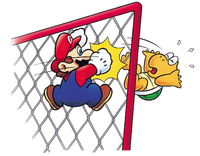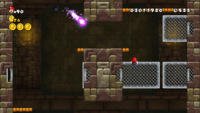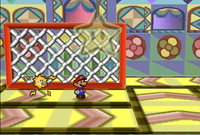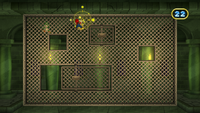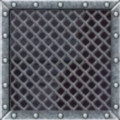Chain-Link
It has been requested that more images be uploaded for this article. Remove this notice only after the additional images have been added. Specifics: images for Wario World
| Chain-Link | |||
|---|---|---|---|
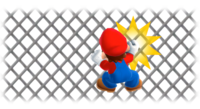 Artwork with Mario from New Super Mario Bros. 2 | |||
| First appearance | Super Mario World (1990) | ||
| Latest appearance | Super Mario 3D World + Bowser's Fury (2021) | ||
| |||
A Chain-Link, also known as a fence, Chain Link Fence,[1] wire net,[2] cage, or metal screen,[3] is an object that player characters can climb along the surface of and punch it to defeat enemies on the other side. In some games, there are panels that can be used to flip the character to the other side. Similar climbable meshes of vines and other interlocking materials appear in Wario Land 3.
History[edit]
Super Mario series[edit]
Super Mario World[edit]
Fences can be jumped on, climbed on, and jumped off of by Mario or Luigi in various castle levels of Super Mario World. Punching a Revolving Door flips the player character to the opposite end of the fence. Climbing Koopas often climb fences, which they can climb to the other side of. Punching a Climbing Koopa on the opposite side of a fence defeats it.[4] The counter for getting more points and an extra life does not reset until the player actually touches the ground, so the player can continue grabbing onto the fence and stomping eight or more Climbing Koopas to gain extra lives, especially in the final room of #4 Ludwig's Castle.
Super Mario 64 / Super Mario 64 DS[edit]
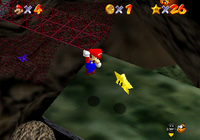
In Super Mario 64 and Super Mario 64 DS, wire nets are designed differently between locations and can also work differently. Hazy Maze Cave, in Bowser in the Fire Sea, and on Tiny-Huge Island has wire nets that the player can only hang on from below and climb horizontally. There are some functionally similar objects such as the bridge near the start of Bob-omb Battlefield, both bridges in the Castle Grounds, the ceiling in front of the Mushroom Castle's main entrance, and the normally inaccessible starting cloud platform in Over the Rainbows.[5]
Other wire nets are instead used as walls that only Vanish Mario can get through, which is used more commonly. Sometimes, this is needed to collect a Power Star, while other times (particularly in the remake), it is simply a shortcut (such as in "Express Elevator--Hurry Up!"). Certain brick walls in Wet-Dry World's downtown work the same way. Sometimes, vertical or block-shaped ones are not found near a Vanish Cap (or Power Flower in the remake) and, as such, are simply used as walls or platforms. This type appears heavily in the Hazy Maze Cave; Dire, Dire Docks; and Tick Tock Clock.
Super Mario Sunshine[edit]
In Super Mario Sunshine, metal screens (also referred to as chain-links)[6] can be climbed in both horizontal and vertical orientations. Many of the metal screens take the form of boxes that enclose enemies and coins, although some are traditionally flat. Metal screens appear in Ricco Harbor, Pinna Park, and Pianta Village and can be used to knock off enemies from the other side. The game also introduces Moving Fences.
New Super Mario Bros.[edit]
Fences return in World 3-![]() Tower and World 4-
Tower and World 4-![]() Tower of New Super Mario Bros., and are featured throughout.
Tower of New Super Mario Bros., and are featured throughout.
New Super Mario Bros. Wii[edit]
Fences are obstacles in Towers and Castles of New Super Mario Bros. Wii, and using the flip panel to go to the opposite side is sometimes necessary to access certain areas. There is also a type of fence that rotates 90 degrees left or right by the first player on it tilting their Wii Remote in either direction. There are giant, circular fences that spin continuously. Also, a yellow fence is used in the Power-up Panels minigame.
New Super Mario Bros. 2[edit]
Fences return in New Super Mario Bros. 2, which also introduces a few others. World 5-![]() Tower has large fences that move up with the rising lava, rotating at times. Moving Fences travel along a track in World 5-Castle, and pressing
Tower has large fences that move up with the rising lava, rotating at times. Moving Fences travel along a track in World 5-Castle, and pressing /
causes it to move either above or below. The flip panels are absent.
New Super Mario Bros. U[edit]
Moving Fences appear in New Super Mario Bros. U. They use their design from Super Mario World, except with red borders instead of gray. Players can no longer punch the fences.
Super Mario 3D World / Super Mario 3D World + Bowser's Fury[edit]
Chain-Links (formatted as Chain Links in the Prima guide[7] and Chainlinks in the PAL release) appear in Super Mario 3D World and Super Mario 3D World + Bowser's Fury in several stages as either stationary walls or platforms or moving along tracks as obstacles. In this game, they cannot be climbed on unless the character assumes the Cat form, but can otherwise simply be used to wall jump.
Super Mario Maker 2[edit]
Chain-Links with platforms on top of them appear in Super Mario Maker 2 in several themes (except ground, ghost house, and desert) in the Super Mario 3D World style as the style's Semisolid Platforms, all of which Cat Mario can climb up, regardless of theme. Unlike in Super Mario 3D World, they can be climbed indefinitely without falling off.
Super Mario World television series[edit]
A small fence makes a brief appearance as an obstacle in Neon Castle in the Super Mario World episode "Mama Luigi". Mario, Luigi and Yoshi are able to easily pass this fence by simply using its revolving gate.
Paper Mario[edit]
Wire nets make a brief appearance in Paper Mario, where they are found in a Conveyor Belt–filled segment of Shy Guy's Toy Box and have a similar function to their appearance in Super Mario 64. To get past them, Mario needs to use Lady Bow's Outta Sight ability while on a Conveyor Belt.
Wario World[edit]
Chain-link fences appear in Wario World, found in Mirror Mansion and Pecan Sands. Unlike in some other games, chain-link fences are always found affixed to solid walls, with only one side accessible to Wario. Wario can climb on them much like the game's ladders, though they have more horizontal layouts. The only actions Wario can take while climbing are movement and jumping off of the fence.
Mario Party series[edit]
Fences appear in a few minigames of the Mario Party series. The Mario Party 7 minigame Funderwall! involves climbing a long fence while avoiding obstacles and attacks from the Koopa Kids. In Mario Party 9, a large fence appears in the Bowser Jr. minigame Cage Match, where it is used the same way as in New Super Mario Bros. Wii. In Mario Party: Island Tour, fences appear as floor during one segment of Gyro for the Gold. In Super Mario Party, a climbable fence appears prominently in Drop Shot.
Mario Kart series[edit]
- Main article: Kanaami Road
Platforms made of Chain-Links, known as Kanaami Roads, appear in some courses in the Mario Kart series, mostly in Mario Kart Tour.
Gallery[edit]
Vanish Metal Mario standing by wire nets in Dire, Dire Docks in Super Mario 64
A metal screen in Ricco Harbor in Super Mario Sunshine
Mario beside a cage of wire nets in Wet-Dry World in Super Mario 64 DS
Vanish Luigi in a cage of wire nets in Tick Tock Clock in Super Mario 64 DS
Naming[edit]
Internal names[edit]
| Game | File | Name | Meaning
|
|---|---|---|---|
| Super Mario Sunshine | bamboofence_rail[8] | bamboo fence rail | bamboo fence |
Names in other languages[edit]
| Language | Name | Meaning | Notes |
|---|---|---|---|
| Japanese | Kanaami |
Wire Netting | |
| フェンス[12] Fensu |
Fence | ||
| Chinese (simplified) | 铁网[?] Tiěwǎng |
Iron Mesh | |
| Chinese (traditional) | 鋼絲網[13] Gāngsīwǎng |
Steel Wire Mesh | |
| French | Grillage[?] | Fence | |
| German | Zaun[?] | Fence | |
| Italian | Rete[14] | Net | |
| Filo elettrico[15] | Electrical wire | ||
| Recinzione[16][17] | Fence | ||
| Rete metallica[18] | Wire net | ||
| Grata[19] | Grate | ||
| Korean | 철망[?] Cheolmang |
Wire Netting | |
| Portuguese (NOE) | Cerca Móvel[20] | Mobile Fence | |
| Russian | Сетка[?] Setka |
Fence | |
| Spanish | Valla[?] | Fence |
References[edit]
- ^ September 1991. Nintendo Power Volume 28. Nintendo of America (English). Page 17.
- ^ 1996. Super Mario 64 instruction booklet (PDF). Nintendo of America (English). Page 13 and 19.
- ^ 2002. Super Mario Sunshine instruction booklet. Nintendo of America (English). Page 26.
- ^ "When the Koopa is on the opposite side, Mario can punch it by pushing the X or Y Button." – June 1991. Mario Mania Player's Guide. Nintendo of America. Page 61.
- ^ UncommentatedPannen (December 5, 2017). All Hangable Ceilings. Retrieved April 13, 2024.
- ^ Averill, Alan, and Jennifer Villarreal (2002). Super Mario Sunshine: The Official Nintendo Player's Guide. Redmond: Nintendo of America. ISBN 1-930206-23-2. Page 46.
- ^ Musa, Alexander, and Geson Hatchett (November 22, 2013). Super Mario 3D World PRIMA Official Game Guide. Prima Games (American English). ISBN 978-0-804-16249-4. Page 20.
- ^ Super Mario Sunshine internal filename (ObjectData/bamboofence_rail.dae)
- ^ 1990. スーパーマリオワールド (Sūpā Mario Wārudo) instruction booklet (PDF). Tokyo: Nintendo Co., Ltd.. Page 16.
- ^ 1996. スーパーマリオ
64 (Sūpā Mario Rokujūyon) (PDF). Nintendo (Japanese). Page 13 and 19. - ^ 2002. スーパーマリオサンシャイン (Sūpā Mario Sanshain) instruction booklet. Nintendo (Japanese). Page 26.
- ^ October 19, 2015. Super Mario Bros. Hyakka: Nintendo Kōshiki Guidebook, Super Mario Sunshine section. Shogakukan (Japanese). ISBN 978-4-09-106569-8. Page 105.
- ^ Online Chinese manual for New Super Mario Bros. 2 (PDF). Nintendo HK (Traditional Chinese). Retrieved March 1, 2020.
- ^ Super Mario World Italian manual. Page 13.
- ^ Super Mario 64 European manual. Page 33.
- ^ New Super Mario Bros. European manual. Page 92.
- ^ New Super Mario Bros. 2 Italian quick guide
- ^ New Super Mario Bros. Wii Italian manual. Page 20.
- ^ November 15, 2018. Super Mario Bros. Enciclopedia. Magazzini Salani (Italian). ISBN 889367436X. Page 91.
- ^ Canal New Super Mario Bros. U (January 11th, 2013). New Super Mario Bros. U - Mar de Menta-CASTELO - Terceira Moeda-Estrela (Wii U) video description. YouTube (European Portuguese). Retrieved June 24, 2024.
- Climbable objects
- Bowser's Fury objects
- Mario Party 9
- New Super Mario Bros. objects
- New Super Mario Bros. 2 objects
- New Super Mario Bros. U objects
- New Super Mario Bros. Wii objects
- Super Mario 3D World objects
- Super Mario 64 objects
- Super Mario Maker 2 objects
- Super Mario Sunshine objects
- Super Mario World objects
- Wario World objects
